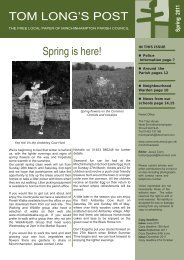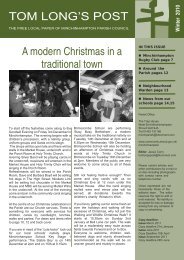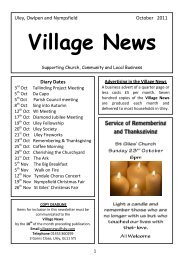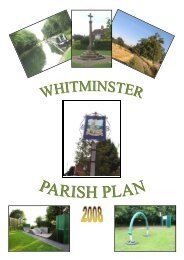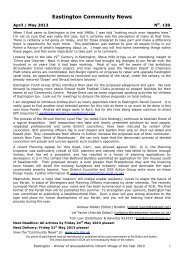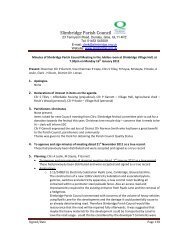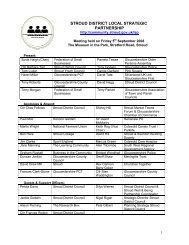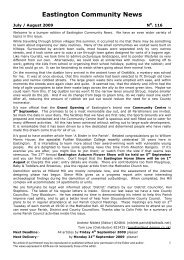An Historical Introduction to Minchinhampton
An Historical Introduction to Minchinhampton
An Historical Introduction to Minchinhampton
You also want an ePaper? Increase the reach of your titles
YUMPU automatically turns print PDFs into web optimized ePapers that Google loves.
Like many other places in the realm, charters were passed elevating Minchinhamp<strong>to</strong>n <strong>to</strong> the statusof a <strong>to</strong>wn, giving the right <strong>to</strong> hold a market and extract <strong>to</strong>lls, the first probably in 1213. This waswhen it first became known as Minchin-Hamp<strong>to</strong>n, from the old word mycenen meaning nun. A latercharter was granted by Henry III, which, when confirmed at Winchester on September 29 th 1269,stated “our beloved in Christ the Abbess and Nuns of Caen that they and their successors shouldforever be permitted <strong>to</strong> have a weekly market on Tuesday at their manor of Hamp<strong>to</strong>n Monialium(Minchinhamp<strong>to</strong>n) in the County of Gloucester and a yearly fair there lasting five days namely onthe Eve and Feast of Holy Trinity and the three days following”. It was, of course, the income fromthe <strong>to</strong>lls that was of interest <strong>to</strong> the absentee landlords at Caen, and it was a jealously guarded right,as another market opening close by would affect trade.With the spread of Christianity in Saxon times people began <strong>to</strong> gather around the churches <strong>to</strong>celebrate holy days and this became a chance for the sale of surplus goods, because travel was slowand sometimes dangerous and the crowds were in one place. As a priest is recorded in 1086 theremust have been a religious building in Hamp<strong>to</strong>n, but no trace of it remains. By Norman times thechurch was the most weatherproof building in a locality, and would be used for many secularpurposes such as courts, s<strong>to</strong>rage of valuables and meetings, and the porch or churchyard was anobvious site for a market. The original Holy Trinity Church, taking its dedication from the motherchurch in Caen, seems <strong>to</strong> have been similar <strong>to</strong> Holy Cross at Avening, but was in a parlous state inthe C19 th when the nave and chancel were rebuilt. Fortunately the south transept with its excellentrose window remains. The spire has had its present truncated form for many centuries; the timberswould not support the <strong>to</strong>tal weight of s<strong>to</strong>ne and it had <strong>to</strong> be finished with the distinctive corona.A statute was passed in 1285 forbidding fairs in churchyards, and by 1448 trading on a Sunday wasbanned, making Saturday the market day in many places. The trading activities had <strong>to</strong> move awayfrom the churchyard, but often set up “just over the wall” and Minchinhamp<strong>to</strong>n, like many other<strong>to</strong>wns, has its market place very close <strong>to</strong> the church. The market place was probably much largerthen, with stalls set up in what we know as Bell Lane and the area on which the present MarketHouse stands being open space. For the visi<strong>to</strong>r or resident alike, <strong>to</strong> s<strong>to</strong>p at the bot<strong>to</strong>m of Bell Laneand take a moment <strong>to</strong> visualise a manor house <strong>to</strong> the west, church <strong>to</strong> the east and market place <strong>to</strong> thesouth is <strong>to</strong> take a step back in time <strong>to</strong> the centre of the mediaeval <strong>to</strong>wn of Minchinhamp<strong>to</strong>n. Thearea around Hamp<strong>to</strong>n Fields was common arable land, worked on a three-field system, there waspasture in the valleys and woodland covered much of the hill<strong>to</strong>p, grazed by animals under ancientrights, which survive <strong>to</strong> this day on the commons. Much of this wood was gradually enclosed andthe timber cut and sold, with only the names such as Box, Beechknapp and Forwood <strong>to</strong> remind us ofthis heritage.




